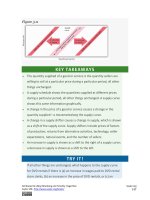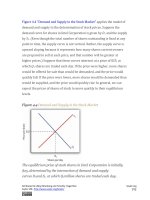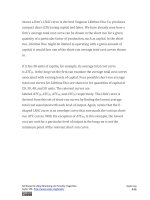Authors libby rittenberg 409
Bạn đang xem bản rút gọn của tài liệu. Xem và tải ngay bản đầy đủ của tài liệu tại đây (511.94 KB, 1 trang )
9. Consider a consumer who each week purchases two goods, X and
Y. The following table shows three different combinations of the
two goods that lie on three of her indifference curves—A, B,
and C.
Indifference
Curve
Quantities of
goods X and Y,
respectively
Quantitities of
goods X and Y,
respectively
Quantities of
goods X and Y,
respectively
A
1 unit of X and 4
of Y
2 units of X and 2
of Y
3 units of X and 1
of Y
B
1 unit of X and 7
of Y
3 units of X and 2
of Y
5 units of X and 1
of Y
C
2 units of X and 5
of Y
4 units of X and 3
of Y
7 units of X and 2
of Y
1. With good X on the horizontal axis and good Y on the vertical
axis, draw the implied indifference curves. Be sure to label all
curves and axes completely.
2. On Curve A, what is the marginal rate of substitution (MRS)
between the first two combinations of goods X and Y?
3. Suppose this consumer has $500 available to spend on goods
X and Y and that each costs $100. Add her budget line to the
graph you drew in part (a). What is the slope of the budget
line?
4. What is the utility-maximizing combination of goods X and Y
for this consumer? (Assume in this exercise that the utilitymaximizing combination always occurs at one of the
combinations shown in the table.)
5. What is the MRS at the utility-maximizing combination?
6. Now suppose the price of good X falls to $50. Draw the new
budget line onto your graph and identify the utilitymaximizing combination. What is the MRS at the utilityAttributed to Libby Rittenberg and Timothy Tregarthen
Saylor URL: />
Saylor.org
409









